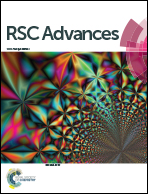Chlorination of florfenicol (FF): reaction kinetics, influencing factors and by-products formation†
Abstract
Florfenicol (FF) is a widely used antibiotic, which is commonly found in natural waters. In this study, we investigated the removal fate of FF in two different drinking water treatment plants (DWTPs), which suggest that FF was easily transformed by free available chlorine (FAC) and the potential reactions of FF with FAC was the focus of this study. The oxidation kinetics of FF by FAC (7 × 10−4 mol) are very rapid with large pseudo-first-order rate constants kobs = 0.31 min−1, while FF (5 mg L−1) can be completely transformed in 30 min. The results showed that high Cl− (the dominant seawater constituent), Br−, and lower humic acid (HA, main constituents in freshwater) favor the FF oxidation. 21 degradation products were identified by liquid chromatography-tandems mass spectrometry (LC-MS/MS) and the possible routes for FF chlorination were proposed. These results are of importance toward the goal of assessing the persistence of FF in water chlorination.


 Please wait while we load your content...
Please wait while we load your content...